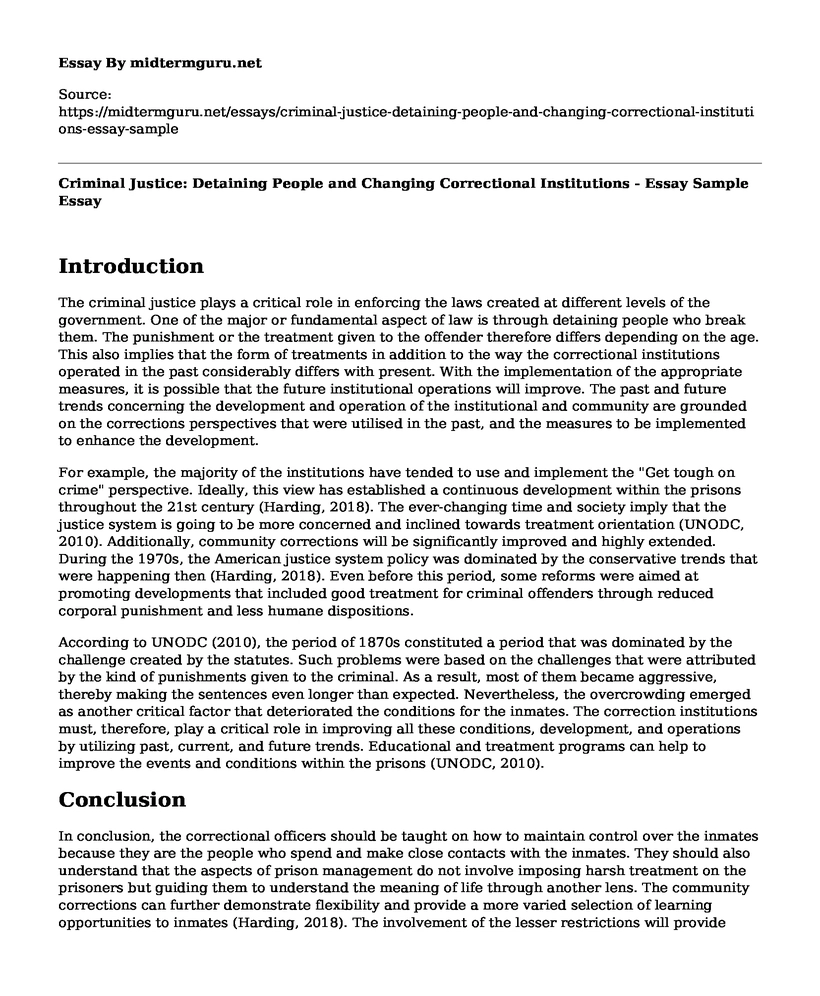Introduction
The criminal justice plays a critical role in enforcing the laws created at different levels of the government. One of the major or fundamental aspect of law is through detaining people who break them. The punishment or the treatment given to the offender therefore differs depending on the age. This also implies that the form of treatments in addition to the way the correctional institutions operated in the past considerably differs with present. With the implementation of the appropriate measures, it is possible that the future institutional operations will improve. The past and future trends concerning the development and operation of the institutional and community are grounded on the corrections perspectives that were utilised in the past, and the measures to be implemented to enhance the development.
For example, the majority of the institutions have tended to use and implement the "Get tough on crime" perspective. Ideally, this view has established a continuous development within the prisons throughout the 21st century (Harding, 2018). The ever-changing time and society imply that the justice system is going to be more concerned and inclined towards treatment orientation (UNODC, 2010). Additionally, community corrections will be significantly improved and highly extended. During the 1970s, the American justice system policy was dominated by the conservative trends that were happening then (Harding, 2018). Even before this period, some reforms were aimed at promoting developments that included good treatment for criminal offenders through reduced corporal punishment and less humane dispositions.
According to UNODC (2010), the period of 1870s constituted a period that was dominated by the challenge created by the statutes. Such problems were based on the challenges that were attributed by the kind of punishments given to the criminal. As a result, most of them became aggressive, thereby making the sentences even longer than expected. Nevertheless, the overcrowding emerged as another critical factor that deteriorated the conditions for the inmates. The correction institutions must, therefore, play a critical role in improving all these conditions, development, and operations by utilizing past, current, and future trends. Educational and treatment programs can help to improve the events and conditions within the prisons (UNODC, 2010).
Conclusion
In conclusion, the correctional officers should be taught on how to maintain control over the inmates because they are the people who spend and make close contacts with the inmates. They should also understand that the aspects of prison management do not involve imposing harsh treatment on the prisoners but guiding them to understand the meaning of life through another lens. The community corrections can further demonstrate flexibility and provide a more varied selection of learning opportunities to inmates (Harding, 2018). The involvement of the lesser restrictions will provide vocational training or a strict and structured job training.
Reference
Harding, R. (2018). Private prisons and public accountability. Routledge.
UNODC (2010): Handbook for prison leaders: A basic training tool and curriculum for prison managers based on international standards and norms. New York: United Nations.
Cite this page
Criminal Justice: Detaining People and Changing Correctional Institutions - Essay Sample. (2023, Jan 31). Retrieved from https://midtermguru.com/essays/criminal-justice-detaining-people-and-changing-correctional-institutions-essay-sample
If you are the original author of this essay and no longer wish to have it published on the midtermguru.com website, please click below to request its removal:
- Three Canadian Legislation Act Paper Example
- Barriers to Communications in Research Work - Paper Sample
- Paper Example on Spatial Justice in Uganda
- Corporations: The Power to Shape Policy and Impact Lives - Essay Sample
- The Cognitive Dissonance Theory and the Stanford Prison Experiment - Research Paper
- Beelow's Steakhouse: A Family Business Internship - Essay Sample
- Public Administration: Trust & Toxic Environments - Essay Sample







